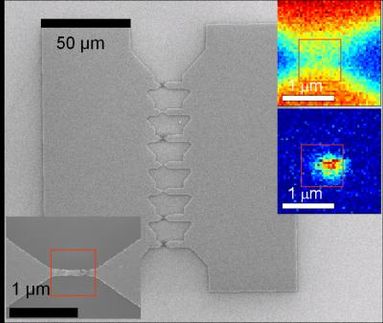Enabling graphene-based technology via chemical functionalization
graphene is an atomically thin sheet of carbon that has attracted significant attention due to its potential use in high-performance electronics, sensors and alternative energy devices such as solar cells. While the physics of graphene has been thoroughly explored, chemical functionalization of graphene has proven to be elusive.
Now researchers at Northwestern University have identified conditions for chemically functionalizing graphene with the organic semiconductor perylene-3,4,9,10-tetracarboxylic-dianhydride (PTCDA).
PTCDA self-assembles into a molecularly pristine monolayer that is nearly defect-free as verified by ultra-high vacuum scanning tunneling microscopy. In addition, the PTCDA monolayers are stable at room temperature and atmospheric pressure, which suggest their use as a seeding layer for subsequent materials deposition.
Through chemical functionalization and materials integration, the outstanding electrical properties of graphene likely can be exploited in a diverse range of technologies including high-speed electronics, chemical and biological sensors and photovoltaics.
"Graphene has captured the imagination of researchers worldwide due to its superlative and exotic electronic properties," said Mark Hersam, who led the research team. He is professor of materials science and engineering in Northwestern's McCormick School of Engineering and Applied Science and professor of chemistry in the Weinberg College of Arts and Sciences.
"However, harnessing these properties requires the development of chemical functionalization strategies that will allow graphene to be seamlessly integrated with other materials that are commonly found in real-world technology," said Hersam. "The stability and uniformity of the chemistry demonstrated here suggest that it can be used as a platform for many device applications."
Original publication: Nature Chemistry, published online May 17
Most read news
Topics
Organizations
Other news from the department science

Get the analytics and lab tech industry in your inbox
By submitting this form you agree that LUMITOS AG will send you the newsletter(s) selected above by email. Your data will not be passed on to third parties. Your data will be stored and processed in accordance with our data protection regulations. LUMITOS may contact you by email for the purpose of advertising or market and opinion surveys. You can revoke your consent at any time without giving reasons to LUMITOS AG, Ernst-Augustin-Str. 2, 12489 Berlin, Germany or by e-mail at revoke@lumitos.com with effect for the future. In addition, each email contains a link to unsubscribe from the corresponding newsletter.





















































